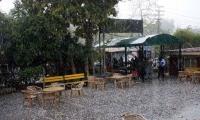The Karachi Bachao Tehreek (KBT) recently held a discussion on the controversial environmental impact assessment (EIA) report of the National Disaster Management Authority (NDMA) and the Sindh Environmental Protection Agency’s (Sepa) farce public hearing on the revamping and restoration of the Gujjar, Orangi and Mehmoodabad storm water drains, along with the Malir and Lyari rivers.
The KBT is an evolving and growing movement for the demolition-affected people and their allies in Karachi. During the discussion held at the Irtiqa Institute of Social Sciences, Muhammad Toheed, senior researcher at the IBA’s Karachi Urban Lab, pointed out how there were major flaws in the planning perspective of the EIA, which also lacked a holistic approach.
“I was surprised how this report was presented for the three big rain drains of the city,” he said, adding that due to the project, several settlements are being directly affected.
The public hearing of the project was held on November 30. The participants of the hearing walked out of it because representatives of the project’s main proponent, the NDMA, were absent.
Officials of the Karachi Metropolitan Corporation (KMC), under whose administrative control these drains fall, the Karachi Water & Sewerage Board (KWSB), whose sewage flows in these drains, and the Sindh Solid Waste Management Board (SSWMB) were also uncannily absent.
The NDMA had hired Lahore-based Pak Green Enviro-Engineering for the EIA of the project. The NDMA’s Lt Col Kamran Adalat submitted the report to Sepa. Toheed pointed out how the EIA report itself mentions that no project would commence construction or operation unless it had filed the initial environmental examination (IEE) or the EIA with Sepa, and had obtained the agency’s approval for the project.
“Sepa would review the IEE and the EIA and accord approval, subject to such terms and conditions as it may prescribe or require,” read the report. He asked that how on earth the EIA can take place more than one year after the commencement of the project.
There are severe discrepancies in terms of the population count of the city. According to Toheed, his undergrads can file a better EIA than the one filed by the Pak Green Enviro-Engineering. Neither was there any coordination among the report writers nor did the report have any cohesion, he said.
As for the resettlement and compensation cost of the project-affected people, he said the EIA mentions in its land acquisition and compensation chapter that compensation will come in the shape of two years’ worth of rent calculated at Rs15,000 a month, totalled at Rs360,000 over two years.
The EIA report mentions nothing of the Sindh government’s claim of the rehabilitation of the affected people in Taiser Town. “If the rehabilitation is to take place in Taiser Town, why isn’t it mentioned in the EIA report?” he asked.
Moving forward, he said the Pak Green Enviro-Engineering used decades-old maps for the EIA. In one of the maps, they showed six districts of the city, which now has seven districts.
“Apart from the map, they also wrote in the report that Karachi has six districts. If a company doesn’t know how many districts this city has, how can it make such an important EIA report and charge millions of rupees from the NDMA? This is a huge risk for the city,” he said. In another map, he pointed out, the company didn’t mention the Korangi district of the city.
Toheed said that for any research work or report, the latest data has to be cited or obtained. For the land use, the company has used the data of 2006.
As for water supply, the NDMA’s report prepared by the Pak Green Enviro-Engineering mentions that Karachi’s water demand is 800 MGD, which in reality is 1,100 MGD. Even on the KWSB’s website, he said, the water demand of the city is 972 MGD.
The NDMA, he said, is carrying out development work of this city based on the census conducted in 1998. The ethnicities, conflicts and vulnerabilities mentioned in the report, according to Toheed, were based on the 1998 census.
The KBT’s Aadil Ayub pointed out that a single EIA had been conducted for five different projects, due to which five different settlements were being affected, for which only one stakeholder consultation had been held.
Ayub said that 65 to 70 respondents were selected by the Lahore-based consultant, and out of those, one to five per cent were women. He said that there are three nullahs that are at different locations, having different impacts and different constituents, “but they’re all being rolled up into one and being represented by a single EIA”.
The KBT’s Advocate Abeera Ashfaq said they will write to Sepa and tribunals, as well as approach the Sindh High Court against the farce EIA.
This hearing, she said, had dubious legal status because it should have been conducted before homes were demolished, and people were made to suffer irreparable losses and damages, undergoing immense pain and suffering.
She pointed out that the stakeholder consultation was bogus because there were so many communities, and within them there was so much diversity, which was not represented in the EIA.
Commuters make their way along a busy street in Karachi. — AFP/FileMapping the InvisibleThe AAN Art Space & Museum...
Representational image shows the identity cards. — Geo News/FileThe decision to declare the Computerised National...
Representational image of inmates behind jail bars. — Unsplash/FileA sessions court has sentenced two men to...
The Sindh High Court building can be seen in this image. — SHC Website/FileThe Sindh High Court on Thursday issued...
Sindh Chief Minister, Syed Murad Ali Shah exchanges views with Chairman Prime Minister Youth Program Rana Mashood...
A health worker administrates polio-vaccine drops to a child during anti-polio immunisation campaign, in Hyderabad on...







